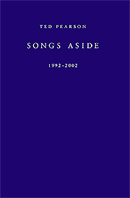Songs Aside appears to collect ten years’ poetry by Ted Pearson into a single volume. Depending on how one reads the book, this represents 120 poems gathered into four sequences, or four poems with 120 sections between them, or even – the way I’ve been reading it – a single extended meditation. I just don’t hear it as accidental that Pearson’s movements of 36, 24, 24 & 36 parts apiece occur with such symmetry. Nor does the symmetry stop there. All 120 pieces use precisely the same form: four stepped couplets, moving across the page not unlike the poetry of the later Williams or of Larry Eigner. In each case the third couplet “steps back” to align vertically with the second line of the first. The result is what I would call a step, forward, back, forward progression that is the closest thing I’ve ever seen in poetry to the box step of the waltz.
Polis is spoils
in mirrored shades
of works and days
an old refrain
the sting of which
collective sweat
a cool breeze
don't explain
For a sax player like Pearson – a one-time student of Lee Konitz if I’m not mistaken – the proliferation of possibilities in this space, barely more than twice that of a haiku, is almost without limit. At a reading at Kelly Writers House in 2004 (in which you can the final two sections of this book), Pearson himself referred to Songs Aside as a quartet, and the individual sections as movements. This poem, the first in “The Devil’s Aria,” starts off the first of the book’s two sequences to make heavy & pointed use of rhyme (another symmetry: the second & fourth sections of the book use rhyme, the first & third for the most part don’t – hence 60 poems of each variety). & while this poetics has, and is aware of, many antecedents & affinities – Pearson at Writers House mentions Blake, Mallarmé & Celan as its “presiding ghosts,” while I hear also Dickinson & Rakosi – so many of its particular pleasures are pure Pearson: the way the first line above builds from the first & third words being near anagrams of the other, the shift to an almost cyberpunk image of sunglasses, then in the third line the title of Hesiod’s poem, which often enough is translated into the Latin as Opera et Dies, an echo of Pearson’s own sequence’s title, and whose argument is largely what follows, tho given a sharp final twist with that disagreement in number at the start of the very last line.
There is a lot of compression here for a poem that plays so lightly on the ear & the push-pull of those two aspects are a primary feature of many of the poems. In the final section, which takes its name, “Parker’s Mood,” from Charlie Parker’s last composition, a condensed history of blues & jazz, Pearson allows found language to pile up in the ear in ways that will recall Christian Bök:
amber waves
triple-filtered and
stored in staves
the vox pop shops
for boss tops
but the prize is
on the bottom
The result is as familiar as cliché, but feels also totally inevitable. The model here of Blake’s Songs of Innocence and Experience serves Pearson well. And the use of pop culture gives the piece a rough surface quite at odds with its formal dance. This is not – and this is where you can see the generation’s difference between Pearson, say, and the likes of Creeley – form as an extension of content, but rather the two quite literally pulling at one another. It yields a poetry that, even when it takes on very public topics – both
In fact, as I read Pearson’s own comments at the end of an elegy of sorts to Creeley, Songs Aside constitutes the third movement itself in a quartet of serial poems dating back to 1975 entitled The Tune’s Image. Which is to say that this spare, almost minimalist work is simply one facet of a project that must be on the scale of 300 pages long. That’s awesome to contemplate, and – just as I want there to be a big Collected, one that gathers all the work from Evidence: 1975-1989 & all the work after – this volume from Past Tents Press makes me hungry to see the whole of this cycle.
And to see some serious distribution as well. Pearson has had one volume from Leslie Scalapino’s O Books, one from Roof, and early in his career one work as an issue of Origin & another from Gil Ott’s Singing Horse Press. But more often he’s appeared from Larry Price’s Gaz & Keith Shein’s Trike, presses that do great work printing books, but do so few that they have only the most tenuous circulation & not nearly the “brand equity” they deserve. Then there are the volumes from Homeboy and Square Zero. It’s strange to think that Pearson’s most well distributed book just might be from a press in the






